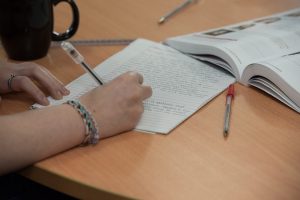Dr Alison Lamont works in the Department of Social Sciences at the University of Roehampton. She has worked in partnership with HMP Belmarsh on a Learning Together programme, ‘Understanding Justice.’ In this guest blog we hear about some of the challenges, and rewards, of this unique teaching experience.
 I am a Sociology and Criminology Lecturer at the University of Roehampton and this is the second year I have taught a 10-week Learning Together module, ‘Understanding Justice’ in HMP Belmarsh. We’re accredited, so all 20 of my students (10 Belmarsh-based and 10 Roehampton-based) get recognised with University credits, and they all sit through the same weekly classes, battle with the same stack of reading and will write (different!) answers to the same essay come December.
I am a Sociology and Criminology Lecturer at the University of Roehampton and this is the second year I have taught a 10-week Learning Together module, ‘Understanding Justice’ in HMP Belmarsh. We’re accredited, so all 20 of my students (10 Belmarsh-based and 10 Roehampton-based) get recognised with University credits, and they all sit through the same weekly classes, battle with the same stack of reading and will write (different!) answers to the same essay come December.
It’s not a bad environment to explore some of these questions: does punishment try to change future behaviour?
The module itself addresses itself to the abstract question of justice and how it connects to the concrete experience of punishment. It’s not a bad environment to explore some of these questions: does punishment try to change future behaviour? My Belmarsh-based students will tell me of all the courses they do in the prison to demonstrate their reformed character and how you only get out of them what you’re willing to put into them. Or should punishment be about communicating and redressing wrongs done to the community? Cue a wide-ranging debate about where the money confiscated as “the proceeds of crime” ends up – in the police pockets, or back in the bank’s coffers from whence it came? My Roehampton-based students remember something from another module in their degree, and about restorative practices in rape cases. Can that count as redressing wrongs? The discussions my students bring to the table are some of the most interesting across all the modules I teach. Because we have such a jumble of different life experiences lodged in a room together, there’s always something new to listen to, an alternative slant on the same reading.
The discussions my students bring to the table are some of the most interesting across all the modules I teach.

HMP Belmarsh is a Cat A prison and it’s difficult to get into each week. For one thing, it’s far away and travel takes at least 90 minutes for most of us coming to the classroom. Then there’s airport-style security checks getting in, and a pre-course talk about making sure I’m the only person handling the wodge of paper I take in each week, to safeguard against drugs. Then there’s getting the Belmarsh-based students unlocked and brought to the Chapel, our teaching space. It’s a collaborative effort which involves a lot of draw from across the prison, including the occupants themselves, officers, orderlies, chaplains, education, and Reducing Reoffending teams. Like a Formula One racing team, there’s a lot of focus on the people in the cars but without the technicians, there would be no way of getting the stars on the road. Similarly, without the circulation of visitor lists and unlock lists, the work of security and the front gate, endless copying and printing, the University’s issuing of student email addresses for a group of students with no Internet access, none of us would be sat together talking about indeterminate sentencing in light of consequentialist models of justice.
Like a Formula One racing team, there’s a lot of focus on the people in the cars but without the technicians, there would be no way of getting the stars on the road.
 Learning Together, as the name implies, emphasises togetherness of learning, both physically and through shared intellectual engagement. Yet it has also meant that we have brought together two enormous bureaucracies – and within those bureaucracies are scatterings of people who may never have thought about universities or prisons before in the course of their prison or university job. As we walk into the establishment, and as I explain my absence from another staff meeting, we are bringing together far more than our learners.
Learning Together, as the name implies, emphasises togetherness of learning, both physically and through shared intellectual engagement. Yet it has also meant that we have brought together two enormous bureaucracies – and within those bureaucracies are scatterings of people who may never have thought about universities or prisons before in the course of their prison or university job. As we walk into the establishment, and as I explain my absence from another staff meeting, we are bringing together far more than our learners.
Want to set up your own partnership or get tips for an existing collaboration? Our PUPiL toolkit shares the what, how and why of prison-university partnerships.
This is part of the Prison University partnerships blog series, which shines a spotlight each month on an example of prisons and universities working in partnership to deliver education. If you would like to respond to the points and issues raised in this blog, or to contribute to the blog yourself, please contact Helena.
The photographs used in this piece show learners at HMPYOI Isis.